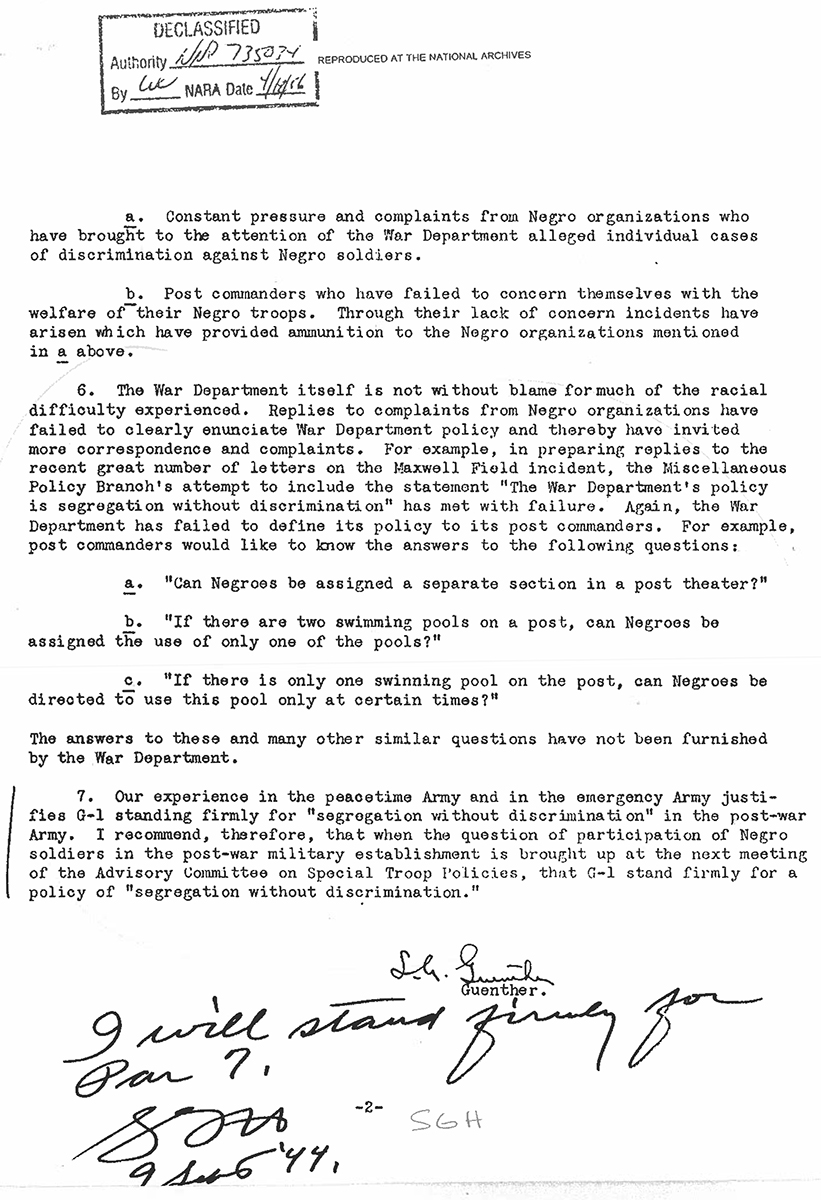Memorandum for Major General S. G. Henry, Army Assistant Chief of Staff, “Participation of Negro Soldiers in the Post-war Military Establishment,” 1944
During WWII, the military command carried out a policy they called “segregation without discrimination.” The policy failed to produce military efficiency, the stated goal of the program. The policy resulted in both the misuse and the underuse of the black Americans who served in the military during WWII. Rigid segregation disadvantaged the black soldier in all social and military settings. Added to the emotional cost of segregating soldiers was the economic cost of building separate facilities and command structures. In this 1944 interdepartment memo, the merits of the policy are highlighted and the staff member suggests that a study be undertaken to ascertain the best postwar usage of black soldiers. Although General Henry advocates continuing the program, these ideas were not the only views on segregated service. Many government officials, military planners, and individual soldiers questioned whether segregation was the most effective way to use human resources in the military. It cost money and energy to maintain duplicate facilities and operations. Noting the efficiency of the Battle of the Bulge experiment, where black volunteers and white infantry soldiers fought in experimental semi-integrated units, some military commanders began to advocate for the desegregation of the armed forces. The military rarely tries anything revolutionary or without precedent; it is a conservative, bureaucratic, and policy-bound institution. Yet, when the military changes policies, the outcome has a ripple effect throughout the American populace. What happens in the military affects all regions and peoples of the nation because the forces are made up of everyday Americans from all regions of the United States.


Questions
Question
Z97j8cN7+SwATi/4Y2LxO0JL0S6wbR1jUvJbYpGFh8igqqluRhwNzvlAijUww6fZEL3K2PEcJ6dV0LiZZ2H67DN8JHbSlCegV1yFKuR6eKiwhjl/x4av8GWZiKAO1Zjhp48MvsHJNbV70cKrnlDKey/H4ZRVZZdJNdZQV5tTlhQCamrbwsl76EsyXh8PPmmCoXuMVAArSvlHBN2OlSvJlUwEpTCJn1tneO6VuokX4DDAUpV2ve+3nV3tWZX8+H5hubmpv3qyJlRYWh80gx7IdM98xck=Question
zcZni4atKwdj7ih8HI3k3Hu1vnpIl8fzcx1RwN2ljQ+tXlDX4L4xjpO0l042lZB5gbIrPxWFxSUEsoa89c0Izt1FyGIYEqMD5wTzrClqRcE7vWb9Lp0woHyBRcd7LLS8HBYV7aHFT4jqfn1/YsMiZgxDGOewm56ttVHLIElNx/YbtlK4/HAnijWnHMxkgYVR5cJb3apw9Z8=